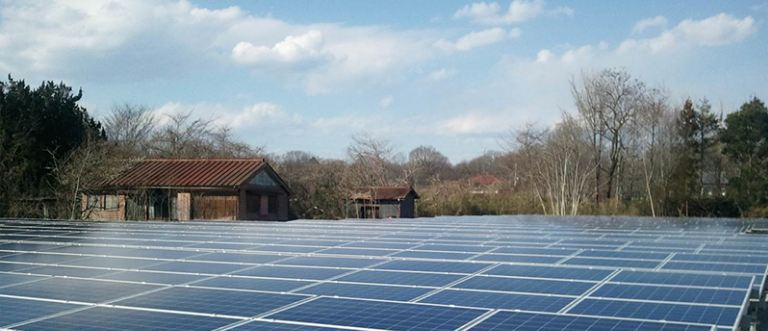Six years after the Fukushima nuclear disaster, Japan is reaching a critical period in establishing its electricity sector model built on renewables, particularly wind and solar power. Its goal is to pave a low-carbon path to energy security and eliminate a long-term dependency on imported fossil fuels and nuclear energy.
A report released by the Institute for Energy Economics and Financial Analysis (IEEFA) states that the country’s dependence on fossil fuel imports has contributed to a reversal in trade balance from 30 years of trade surplus to a deficit that reached $116 billion in 2014.
Government policies adopted in the wake of the Fukushima disaster in 2011 have favored the replacement of nuclear base load power with a fossil fuel base load — a strategy that has proven costly and resulted in lost opportunities in the development of increasingly available renewable energy, says the report, titled Japan: Greater Energy Security Through Renewables.
However, if it is to deliver on its COP 21 climate pledge, the Japanese government needs to further expand its renewables footprint, the report stresses.
The good news is that the increase in energy efficiency has driven down the electricity demand and thereby opened the door to greater investments in renewable energy. What needs to come in first are prudent policy decisions that could attract vast capital to renewable infrastructure.
Solar’s starring role
In the process of reconfiguring of Japan’s electricity industry by 2030, solar PV could amount to 12% of its energy, up from the current capacity 4%, the report highlights. Although the country’s feed-in tariff (FIT) program, introduced in July 2012, was initially very generous, a yearly double-digit decline has moved the tariffs toward grid parity.
As the major beneficiary of the post-Fukushima investment program, solar PV has reached 80 GW capacity since 2012, though some difficulties in securing grid connection and land have deterred the full realization of certain projects. Consequently, Japan was the world’s second largest installer of solar PV in the period between 2013 and 2015. Moreover, the country has seen an increase in the amount of electricity generated from solar PV from 4TWh in FY 2010 to 36TWh in FY 2015.
However, new policy support by the Japanese government is required to perpetuate solar growth, and the recent move towards reverse auctions for large-scale installations suggests that Japan can realize significant further solar cost reductions. The pilot tender in FY 2017 for 500 MW will have an upper bidding price limit of $0.178 per kWh, while an upper price is still to be set for FY 2018 auctions totaling 1GW, states the report.
Current regional restrictions limit the amount of solar capacity that can be installed, and the amount of electricity traded at the wholesale market is marginal. However, the planned market reform and interconnection of regional grids will help with the integration of increased renewable energy capacity.
As for rooftop solar, both the Japan Photovoltaic Energy Association (JPEA) and the nation’s Renewable Energy Institute are targeting 100 GW of solar PV capacity by FY 2030. Although slower than seen in the past few years, FY 2017 solar installations may be as high as 6 GW or 8 GW, finds the report.
Impact of energy efficiency
One of the report’s key findings is that energy productivity gains will drive down electricity demand from 1,140 TWh in FY 2010 to 868 TWh in 2030. The impact of further energy efficiency gains combined with the prospect of low economic growth suggests that there will be a continuing decline in electricity demand and generation through to 2030, the report said.
The report also draws attention to the offshore wind-power resources and their possible contribution to base load power demand (the IEEFA’s projection is 10 GW of offshore wind in Japan by FY 2030).
As for any potential rebound of nuclear power, the IEEFA sees this as unlikely. Though it is expected for only a quarter of Japan’s 40 GW of offline nuclear power capacity to resume operation by 2030, operators are struggling to achieve new safety standards as reactors reach their retirement dates.
In terms of the construction of a new fleet of coal-fired power plants, Japan is very likely to scale this back. Most of the 45 new coal-fired power plants Japan is proposing to build are still in the planning stages and — because of Japan’s declining electricity demand — many will not reach the construction phase, the report reads.
The report concludes that Japan can meet 35% of its electricity needs with renewables by 2030 on the wings of a much-needed policy push to increase solar and offshore wind capacity and probable electricity demand reduction.
This content is protected by copyright and may not be reused. If you want to cooperate with us and would like to reuse some of our content, please contact: editors@pv-magazine.com.




2 comments
By submitting this form you agree to pv magazine using your data for the purposes of publishing your comment.
Your personal data will only be disclosed or otherwise transmitted to third parties for the purposes of spam filtering or if this is necessary for technical maintenance of the website. Any other transfer to third parties will not take place unless this is justified on the basis of applicable data protection regulations or if pv magazine is legally obliged to do so.
You may revoke this consent at any time with effect for the future, in which case your personal data will be deleted immediately. Otherwise, your data will be deleted if pv magazine has processed your request or the purpose of data storage is fulfilled.
Further information on data privacy can be found in our Data Protection Policy.